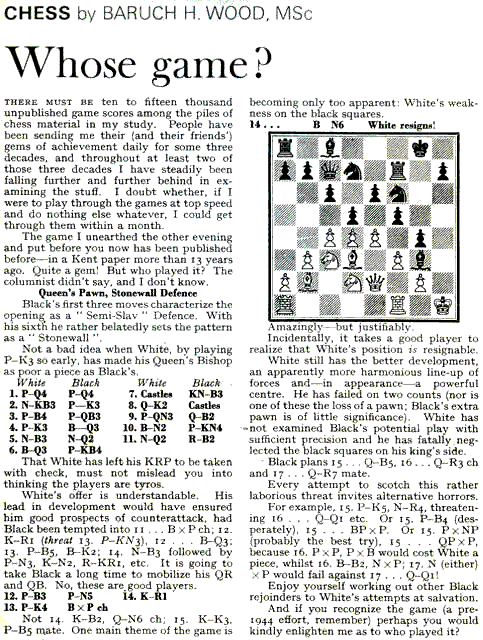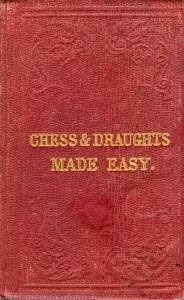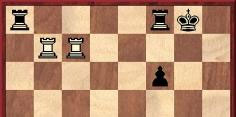


Winning starts with what you know
The new version 18 offers completely new possibilities for chess training and analysis: playing style analysis, search for strategic themes, access to 6 billion Lichess games, player preparation by matching Lichess games, download Chess.com games with built-in API, built-in cloud engine and much more.
Page 19 of V.N. Panov’s monograph on Capablanca (Moscow, 1970) stated that in February 1909 Emanuel Lasker predicted that Capablanca would beat Marshall in the forthcoming match, and that the Cuban might well be a future world title challenger. C.N. 404 asked whether other sources confirmed that these predictions were made, and information is still being sought.
Whose game?
Does any reader recognize this strange game? 1 d4 d5 2 Nf3 e6 3 c4 c6 4 e3 Bd6 5 Nc3 Nd7 6 Bd3 f5 7 O-O Ngf6 8 Qe2 O-O 9 b3 Qc7 10 Bb2 g5 11 Nd2 Rf7 12 f3 g4 13 e4 Bxh2+ 14 Kh1 Bg3 15 White resigns.

C.N. 5225 presented this unidentified cutting, which is probably from the Illustrated London News around 1957. Quite apart from the identity of the players, what is to be made of the game itself or of B.H. Wood’s notes?
The best move
A number of C.N. items, starting with C.N. 2085 (see page 325 of Kings, Commoners and Knaves), have discussed who originated the familiar remark by a master that he saw (or looked) only one move ahead, but it was always the best move. C.N. 4483 quoted from an article by Al Horowitz in Chess Review, May 1946, page 34:
‘Apropos is the story of the game between the invincible Capablanca and Charles Jaffe, pride of the East Side. Capa forgot he was invincible: he lost. A reporter who was present asked the Cuban, “How far do you see ahead?” Capa replied impressively, “About ten moves”. Then the reporter went over to Jaffe: “How far do you see ahead?” Much to everyone’s surprise, the reply was, “Only one move”. This didn’t make sense. “How could a player who can see only one move ahead defeat another who can delve so deeply?” Here Jaffe explained: “I see only one move ahead, but always the best move.” That is sufficient.’
Whether these alleged exchanges ever occurred (i.e. after Jaffe’s win over Capablanca at New York on 2 February 1913) is far from clear, and perhaps a reader can examine the press of the time.
C.N. 5320 mentioned that page 70 of the Dictionary of Modern Chess by Byrne J. Horton (New York, 1959) attributed the quote to Dawid Janowski, for unspecified reasons.
Miniature
An oft-published miniature was given in C.N. 2393:
1 e4 e5 2 f4 exf4 3 Nf3 g5 4 h4 g4 5 Ng5 h6 6 Nxf7 Kxf7 7 d4 d6 8 Bxf4 Nc6 9 Bc4+ Kg7 10 O-O Qxh4 11 Qd3 Nf6 12 e5 Nh5 13 Bg3 Qe7

14 Bh4 Qe8 15 Bf6+ Nxf6 16 exf6 mate.
The usual heading (e.g. on page 200 of Chernev’s 1000 Best Short Games of Chess) is ‘Maurian v Amateur, New Orleans, 1866’. However, the game was published on pages 212-213 of the 15 July 1891 issue of La Stratégie as played between Maurian and B.W. May at the Café de la Régence, Paris on 3 June 1891.

Charles Maurian
Breyer and the last throes
The Hungarian master Gyula Breyer (1893-1921) is regularly quoted as declaring that after 1 e4 White’s game is in the last throes, and C.N. 9 asked if this was apocryphal. Subsequent items showed it to be a particularly complex mystery, as may be seen from our feature article Breyer and the Last Throes.
Bishop book
Nineteenth-century chess books have been covered with great thoroughness by specialized bibliographies, and we have therefore been surprised by the dearth of references to a 33-page book in our collection, Chess & Draughts Made Easy by J. Bishop, which was discussed in C.N.s 2710, 3051 and 5002. Published by A. & S. Joseph Myers & Co. London, it is undated, although the internal evidence suggests that it was published around 1860.

The book’s description of the knight move (page 9) belies the ‘Made Easy’ part of the title:
‘The knight has a very peculiar movement. He moves to the third square distant, in an oblique direction, first through the adjoining square either way, and then to the next adjoining square either way again, entering into the one diagonally, and into the other sideways, and his move is always onto a square of a different colour from that which he previously occupied.’
‘Calculate your moves forward, so that you may safely sacrifice a few pieces to effect your purpose; the loss of a few pieces for the attainment of a position gives brilliancy to the play: such bold attempts make fine games.’
Item 25 was:
‘If ever your game be such that you have scarce anything to play, you have either brought out your pieces wrong, or, what is worse, not at all; for if you had brought them out right, you must have variety enough.’
In C.N. 2710 we suggested that the counsel in item 30 deserved to be writ in letters of gold by chessplayers worldwide:
‘Every now and then examine your game, and then take your measures accordingly.’
It eventually proved possible, in C.N. 5002, for some more information on the book to be supplied. Michael Clapham (Ipswich, England) reported that he had recently inspected a copy at the British Library in London:
‘The book is undated, but the British Library dates it as circa 1855. It is a delightful little work bound in blue cloth-covered boards, blind-stamped and with the title on the front cover in gilt. All edges are gilt and the book has lemon glazed endpapers.
I also examined Draughts and Chess for the Millions! – The whole art of chess and draughts published by J. Cleave (London, 1844?), which has chess on pages 3-21 and draughts on pages 21-23. Large parts of the Bishop book up to page 16 are very similar to Draughts and Chess for the Millions. The “Advice to Beginners” from page 16 onwards is largely taken from Hoyle’s Rules for Chess (included in many editions of Hoyle’s Games), which are also in Draughts and Chess for the Millions. There the chess section of the “Millions” book ends, whereas the Bishop work continues with a selection of openings and games.
It is, indeed, curious that Bishop’s book is apparently not mentioned in any chess bibliography or catalogue. I have also ascertained that the book is not recorded in the standard draughts bibliography, The Literature of Checkers by William T. Call (New York, 1908).’
That British Library volume is the only other copy of the book whose existence has been notified to us. A curiosity is that whereas the cover of the edition inspected by Mr Clapham is blue, ours is red. It is not known whether J. Bishop was a pseudonym.

Blind swine
Pages 129-131 of The Chess Kid’s Book of Checkmate by D. MacEnulty (New York, 2004) comprised a chapter entitled ‘The Blind Swine Checkmate’, and C.N. 3494 quoted from page 129:
‘The checkmate that follows from the position in this diagram is called the Blind Swine Mate. Perhaps the name comes from the fact that we call a rook on the seventh rank a pig (because there are usually a lot of enemy pawns for the rook to root around in, or maybe it’s because a rook on the seventh hogs the board), and with doubled rooks on the seventh rank, even a couple of blind pigs could find this checkmate. Actually, this pattern got its name from David Janowski (1868-1927), a Polish grandmaster who referred to a pair of rooks on the seventh rank that could not find a mate as “blind swine”. In this pattern, they do find the mate, so maybe we should change the name, but somehow “the sighted swine checkmate” doesn’t sound right.’
The next page of MacEnulty’s book had this diagram (no white king) with the caption ‘Blind Swine Mate’:

1 Rxg7+ Kh8 2 Rxh7+ Kg8 3 Rbg7 mate.
From our reading, the term seems to occur mainly in German-language sources. For example, the following entry is on page 44 of Lexikon für Schachfreunde by M. van Fondern (Lucerne and Frankfurt, 1980):
‘Blinde Schweine, von Janowski erfundener Ausdruck; obwohl ein Turm auf der 7. Reihe eine wichtige strategische Funktion erfüllt, können in der Diagrammstellung die verdoppelten Türme kein Matt erzwingen.’
An almost identical definition and diagram were given on page 40 of Grosses Schach-Lexikon by K. Lindörfer (Munich, 1991).
C.N. 3525 quoted the following sourceless assertion on page 65 of Chess Rules of Thumb by L. Alburt and A. Lawrence (New York, 2003):
‘Nimzowitsch called a pair of rooks on the opponent’s second rank “blind pigs” because they devour everything indiscriminately.’
In C.N. 5160 James Stripes (Spokane, WA, USA) pointed out that the attribution appeared in V. Vuković’s book The Art of Attack in Chess; see, for instance, page 73 of the 1993 edition published by Cadogan Chess.

Vuković gave this diagram with the caption ‘Blind swine’ and stated:
‘The pair of rooks which “grunt out check” on the seventh rank but cannot get a sight of mate were once nicknamed “blind swine” by Janowski.’
Our correspondent cited two games in which Janowski could only draw despite having his rooks on the seventh rank: his tenth match-game against Showalter in New York, January 1899 (American Chess Magazine, February 1899, pages 360-361) and his first-round encounter with Marshall at New York, January 1913 (American Chess Bulletin, March 1913, page 54).
How did the term ‘blind swine’ originate?
Mendelssohn?
Alfred Kreymborg (1883-1966) wrote an autobiography entitled Troubadour (New York, 1925), and C.N. 3569 quoted from page 145 a well-known remark about chess:
‘... as the philosopher Mendelssohn declared, “it is too much of a game to be a science and too much of a science to be a game”.’
We asked whether it was indeed the German philosopher and biblical scholar Moses Mendelssohn (1729-1786) who made that observation. After all, a similar comment (‘Chess is too earnest for a game; too much of a game to be earnest about.’) was attributed to his grandson, the composer Felix Mendelssohn (1809-1847), on, for example, page 144 of Caissa’s Web by G. Harwood (London, 1975).
C.N. 3676 added that page 48 of the Chess Player’s Chronicle, 11 July 1883 quoted the following from a recent issue of the Jewish Chronicle: ‘And yet Mendelssohn said, “For a game, it is too serious, for study, it is too much like play”.’ The context implied, though no more than that, that Moses Mendelssohn was being referred to, and it is the only instance we have found so far of any such quotation in a pre-twentieth-century source. Then C.N. 4133 cited an extract from page 66 of El maravilloso mundo del ajedrez by Emilio Carrillo Alonso (Mexico City, 2002), which claimed that the remark was made by Gottfried Leibniz:
‘G.W. Leibniz (1646-1719), filósofo y matemático alemán, dijo en alguna ocasión: “El ajedrez es demasiado juego para ser una ciencia y demasiada ciencia para ser un juego”.’
(Alonso was three years out with Leibniz’s year of death.)
C.N. 4378 added that page 316 of volume one of Chess, Jews and History by Victor Keats (Oxford, 1994) had the following regarding Moses Mendelssohn:
‘Mendelssohn is said to have remarked that chess was too serious to be a game and too much of a game to be serious, but from what we have seen, he himself was inclined to disregard this maxim.’
A footnote on the same page read:
‘See e.g. L. Dukes in Ben Chananja, 7 (1864), page 636; the same remark is also attributed to Montaigne.’
As regards Montaigne, we commented in the same item that the relevant passage occurred in his essay ‘De Democritus et Heraclitus’, which is Chapter L of his Essais. Below is the text as it appears on page 541 of volume one of the ‘Classiques de poche’ series (Paris, 2002), i.e. with modernized spelling but no grammatical changes:
‘Pourquoi ne jugerais-je d’Alexandre à table devisant et buvant d’autant? Ou s’il maniait des échecs, quelle corde de son esprit, ne touche et n’emploie ce niais et puéril jeu? Je le hais et fuis, de ce qu’il n’est pas assez jeu, et qu’il nous ébat trop sérieusement; ayant honte d’y fournir l’attention qui suffirait à quelque bonne chose.’

An English version of the maxim was given on page 21 of Chess Pieces by Norman Knight (London, 1949), and page 123 had other remarks on chess by Montaigne.
Steinitz’s daughter
As noted in C.N. 3189, on page 42 of the February 1888 International Chess Magazine Steinitz wrote in his “Personal and General” feature:
‘This is not a private column, but I beg leave to announce that my most cherished hopes are dead and buried in the grave of my daughter, an only child who, on the 13th ult., died at the age of 21 years from rheumatism of the heart after an illness of nearly four months.’
Steinitz also referred to his daughter’s death on page 84 of the April 1888 issue. We believe that no photograph of her has ever appeared in a chess book, yet the following brief item was published on page 79 of the Columbia Chess Chronicle, 17 March 1888:
‘El Sport, of Havana, devotes the entire first page to a portrait of the late Flora Steinitz.’
Can anybody find that item?
Submit information or suggestions on chess mysteries
 aficionados to discuss all matters relating to the Royal Pastime". Since then around 5,300 items have been published, and the series has resulted in four books by Winter: Chess Explorations (1996), Kings, Commoners and Knaves (1999), A Chess Omnibus (2003) and Chess Facts and Fables (2006). He is also the author of a monograph on Capablanca (1989).
aficionados to discuss all matters relating to the Royal Pastime". Since then around 5,300 items have been published, and the series has resulted in four books by Winter: Chess Explorations (1996), Kings, Commoners and Knaves (1999), A Chess Omnibus (2003) and Chess Facts and Fables (2006). He is also the author of a monograph on Capablanca (1989).
Chess Notes is well known for its historical research, and anyone browsing in its archives will find a wealth of unknown games, accounts of historical mysteries, quotes and quips, and other material of every kind imaginable. Correspondents from around the world contribute items, and they include not only "ordinary readers" but also some eminent historians – and, indeed, some eminent masters. Chess Notes is located at the Chess History Center.